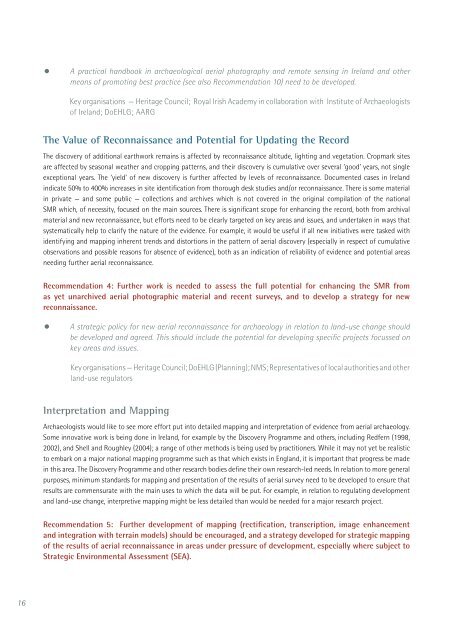Aerial Archaeology in Ireland - The Heritage Council
Aerial Archaeology in Ireland - The Heritage Council
Aerial Archaeology in Ireland - The Heritage Council
You also want an ePaper? Increase the reach of your titles
YUMPU automatically turns print PDFs into web optimized ePapers that Google loves.
16<br />
• A practical handbook <strong>in</strong> archaeological aerial photography and remote sens<strong>in</strong>g <strong>in</strong> <strong>Ireland</strong> and other<br />
means of promot<strong>in</strong>g best practice (see also Recommendation 10) need to be developed.<br />
Key organisations — <strong>Heritage</strong> <strong>Council</strong>; Royal Irish Academy <strong>in</strong> collaboration with Institute of Archaeologists<br />
of <strong>Ireland</strong>; DoEHLG; AARG<br />
<strong>The</strong> Value of Reconnaissance and Potential for Updat<strong>in</strong>g the Record<br />
<strong>The</strong> discovery of additional earthwork rema<strong>in</strong>s is affected by reconnaissance altitude, light<strong>in</strong>g and vegetation. Cropmark sites<br />
are affected by seasonal weather and cropp<strong>in</strong>g patterns, and their discovery is cumulative over several ‘good’ years, not s<strong>in</strong>gle<br />
exceptional years. <strong>The</strong> ‘yield’ of new discovery is further affected by levels of reconnaissance. Documented cases <strong>in</strong> <strong>Ireland</strong><br />
<strong>in</strong>dicate 50% to 400% <strong>in</strong>creases <strong>in</strong> site identification from thorough desk studies and/or reconnaissance. <strong>The</strong>re is some material<br />
<strong>in</strong> private — and some public — collections and archives which is not covered <strong>in</strong> the orig<strong>in</strong>al compilation of the national<br />
SMR which, of necessity, focused on the ma<strong>in</strong> sources. <strong>The</strong>re is significant scope for enhanc<strong>in</strong>g the record, both from archival<br />
material and new reconnaissance, but efforts need to be clearly targeted on key areas and issues, and undertaken <strong>in</strong> ways that<br />
systematically help to clarify the nature of the evidence. For example, it would be useful if all new <strong>in</strong>itiatives were tasked with<br />
identify<strong>in</strong>g and mapp<strong>in</strong>g <strong>in</strong>herent trends and distortions <strong>in</strong> the pattern of aerial discovery (especially <strong>in</strong> respect of cumulative<br />
observations and possible reasons for absence of evidence), both as an <strong>in</strong>dication of reliability of evidence and potential areas<br />
need<strong>in</strong>g further aerial reconnaissance.<br />
Recommendation 4: Further work is needed to assess the full potential for enhanc<strong>in</strong>g the SMR from<br />
as yet unarchived aerial photographic material and recent surveys, and to develop a strategy for new<br />
reconnaissance.<br />
• A strategic policy for new aerial reconnaissance for archaeology <strong>in</strong> relation to land-use change should<br />
be developed and agreed. This should <strong>in</strong>clude the potential for develop<strong>in</strong>g specific projects focussed on<br />
key areas and issues.<br />
Key organisations — <strong>Heritage</strong> <strong>Council</strong>; DoEHLG (Plann<strong>in</strong>g); NMS; Representatives of local authorities and other<br />
land-use regulators<br />
Interpretation and Mapp<strong>in</strong>g<br />
Archaeologists would like to see more effort put <strong>in</strong>to detailed mapp<strong>in</strong>g and <strong>in</strong>terpretation of evidence from aerial archaeology.<br />
Some <strong>in</strong>novative work is be<strong>in</strong>g done <strong>in</strong> <strong>Ireland</strong>, for example by the Discovery Programme and others, <strong>in</strong>clud<strong>in</strong>g Redfern (1998,<br />
2002), and Shell and Roughley (2004); a range of other methods is be<strong>in</strong>g used by practitioners. While it may not yet be realistic<br />
to embark on a major national mapp<strong>in</strong>g programme such as that which exists <strong>in</strong> England, it is important that progress be made<br />
<strong>in</strong> this area. <strong>The</strong> Discovery Programme and other research bodies def<strong>in</strong>e their own research-led needs. In relation to more general<br />
purposes, m<strong>in</strong>imum standards for mapp<strong>in</strong>g and presentation of the results of aerial survey need to be developed to ensure that<br />
results are commensurate with the ma<strong>in</strong> uses to which the data will be put. For example, <strong>in</strong> relation to regulat<strong>in</strong>g development<br />
and land-use change, <strong>in</strong>terpretive mapp<strong>in</strong>g might be less detailed than would be needed for a major research project.<br />
Recommendation 5: Further development of mapp<strong>in</strong>g (rectification, transcription, image enhancement<br />
and <strong>in</strong>tegration with terra<strong>in</strong> models) should be encouraged, and a strategy developed for strategic mapp<strong>in</strong>g<br />
of the results of aerial reconnaissance <strong>in</strong> areas under pressure of development, especially where subject to<br />
Strategic Environmental Assessment (SEA).

















